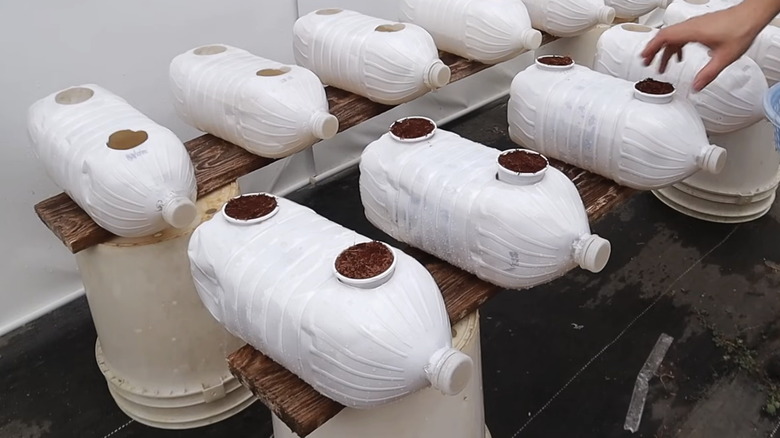How To DIY An Indoor Hydroponic Garden Using Empty Plastic Bottles
Hydroponic gardening is an efficient and relatively mess-free way to garden. With this technique, you grow plants in water with added nutrients and a growing medium rather than dirt. It can be an exciting change for experienced gardeners or an intriguing start for beginners. If you have ever been curious about hydroponic gardening and looked into purchasing a setup, you may have learned why hydroponic gardens are never worth buying. Readymade systems can cost hundreds of dollars for even a small setup, and this high barrier to entry can prevent people from giving the method a try. Luckily, there are plenty of ways to DIY your own. One of the most effective — and easy to create and care for — methods uses gallon-sized water bottles, plastic cups, and a few simple tools.
The project is affordable, easy to scale, and gives you the opportunity to reuse materials that would otherwise be discarded. All you need are some empty gallon-sized water bottles, some small plastic cups, a five-gallon bucket, some growing medium, your choice of seeds, some hydroponics nutrient solution, a hot knife, and some spray paint. The plastic cup size can vary, but a three-ounce cup is ideal. Rockwool, coconut coir, or clay aggregate are the growing mediums used most often, though perlite, vermiculite, or even gravel would also work. Making a single bottle system is very cheap. If you decide to make a very large system, you will need to spend a little more money — you'll need more growing medium and hydroponics nutrient solution, which are the most expensive items.
Creating your hydroponic garden setup from plastic bottles
With all of your supplies prepared, you can begin building your hydroponic system. Start by modifying the water bottles. Lay it on its side and, using a marker, draw or trace on two identical circles with diameters slightly smaller than your plastic cups. The circles should be on the same side of the bottle: one near the neck and the other near the base. Using a hot knife or any other plastic cutting tool you prefer, carefully cut out the circles. If you wish, spray paint the water bottles in a color of your choice, perhaps a hue that matches your exterior or interior aesthetic.
It's time to move on to the plastic cups. Using your hot knife or cutting implement, create small holes that are about ¼ inch in diameter in the base of each cup and about halfway up the sides. These holes will accommodate the plant's roots, so make sure there are a lot of them. Next, fill the cups with your growing medium of choice and plant a seed in each one. There are many options for edible plants you can grow in an outdoor hydroponic garden (or indoors, if you prefer), but shallow-rooted leafy greens and herbs are among the easiest — think lettuce, chard, kale, and basil. Place your water bottles in their permanent location on top of an upturned bucket, fill the bottles with water and hydroponics nutrient solution, and insert the plastic cups into the holes.
How to care for your hydroponics system
As time passes and your plants grow, you will need to replenish the water reserves. Drain the reservoir (the inside of the plastic bottle) every seven to 10 days. Unscrew the cap from the bottle and gently tilt the neck downwards. Mix more of your hydroponics nutrient solution into water according to the manufacturer's directions (each brand is a little different), and refill the bottle. If you notice the water level dipping low before this time period, top up the bottle with fresh water. The amount of water loss will depend, at least partially, on where you place your hydroponic garden. If the plants you chose require a lot of light, place your garden in a sunny spot and be prepared to top up the reservoirs more often.
Hydroponics systems function well indoors or out. However, you may want to keep this particular DIY outside or take special protective measures, like placing plastic sheeting underneath it, if you keep it indoors. Tip over a bottle inside and you will have a little under a gallon of nutrient-filled water and a cup full of growing medium all over your hardwood floors. When your plants are ready to harvest, you don't necessarily have to replace them. For some leafy greens, including kale, lettuce, and chard, you can harvest outside leaves continuously while leaving the plant growing in its cup. Alternatively, use this setup to grow seedlings over the winter, and then transplant the hydroponic plants into your summer garden.


